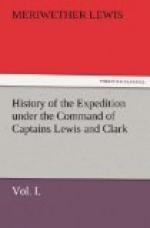Thursday 6. Captain Lewis was now convinced that this river pursued a direction too far north for our route to the Pacific, and therefore resolved to return; but waited till noon to take a meridian altitude. The clouds, however, which had gathered during the latter part of the night continued and prevented the observation: part of the men were sent forward to a commanding eminence, six miles S. 70 degrees W; from which they saw at the distance of about fifteen miles S. 80 degrees W. a point of the south bluff of the river, which thence bore northwardly. In their absence two rafts had been prepared, and when they returned about noon, the party embarked: but they soon found that the rafts were so small and slender that the baggage was wet, and therefore it was necessary to abandon them, and go by land. They therefore crossed the plains, and at the distance of twelve miles came to the river, through a cold storm from the northeast, accompanied by showers of rain. The abruptness of the cliffs compelled them, after going a few miles, to leave the river and meet the storm in the plains. Here they directed their course too far northward, in consequence of which they did not meet the river till late at night, after having travelled twenty-three miles since noon, and halted at a little below the entrance of Lark creek. They had the good fortune to kill two buffaloe which supplied them with supper, but spent a very uncomfortable night without any shelter from the rain, which continued till morning,
Friday 7, when at an early hour they continued down the river. The route was extremely unpleasant, as the wind was high from the N.E. accompanied with rain, which made the ground so slippery that they were unable to walk over the bluffs which they had passed on ascending the river. The land is the most thirsty we have ever seen; notwithstanding all the rain which has fallen, the earth is not wet for more than two inches deep, and resembles thawed ground; but if it requires more water to saturate it than the common soils, on the other hand it yields its moisture




